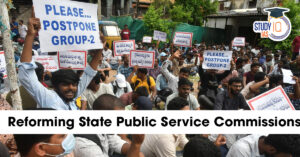Table of Contents
The Central Industrial Security Force (CISF) stands as a cornerstone of India’s internal security framework, safeguarding critical infrastructure from industrial hubs to international airports and now seaports. As a premier Central Armed Police Force (CAPF) under the Ministry of Home Affairs (MHA), CISF’s motto—”Protection and Security”—embodies its unwavering commitment to national safety. With over 177,000 personnel as of 2025, the force has evolved from guarding public sector undertakings (PSUs) to a versatile guardian of modern India’s economic and strategic assets.
In this comprehensive guide, we explore the CISF full form, its rich history, organizational structure, key functions, and the latest updates, including its expanded role in maritime security.
What is the Full Form of CISF?
CISF stands for Central Industrial Security Force. Established as an armed wing of the Union of India, it operates under the CISF Act of 1968, amended in 1983 and 2009 to broaden its mandate. This paramilitary force is uniquely positioned as India’s “airport police” and now extends to seaports, blending industrial protection with high-stakes public interface duties.
History of CISF: From Industrial Guardian to National Shield
The roots of CISF trace back to post-independence India, when the government prioritized heavy industrialization through PSUs. Amid rising labor unrest and security threats in the 1960s, the need for a dedicated federal force became evident.
- Founding (1969): CISF was formally raised on March 10, 1969, under the CISF Act, 1968, with an initial strength of 2,800 personnel across three battalions. Its first deployment was at the Fertilizer Corporation of India in Trombay, Maharashtra, on November 1, 1969, followed by Bokaro Steel Plant.
- Expansion and Armament (1983): An amendment transformed CISF into an armed force, enhancing its capabilities for broader threats.
- Diversification (2000s): Post-1999 amendments allowed deployment in any government-deemed scenario. In 2000, CISF took over aviation security at Jaipur Airport, a pivotal shift after global terror concerns. The 2009 amendment enabled private sector coverage (e.g., Infosys, Reliance) and overseas missions, including UN peacekeeping.
Today, CISF Raising Day on March 10 celebrates this legacy, honoring personnel’s bravery in securing everything from nuclear plants to the Taj Mahal.
Organizational Structure of CISF
Headquartered in New Delhi, CISF is led by a Director General (DG) from the Indian Police Service (IPS). As of October 2025, IPS officer Praveer Ranjan (1993 batch) serves as DG, overseeing strategy, training, and operations.
The force’s structure is hierarchical and sector-based:
| Level | Leadership | Key Responsibilities |
|---|---|---|
| Apex | Director General (DG, IPS) | Overall command, policy formulation |
| Senior | Additional DGs/Special DGs | Functional sectors (e.g., Airport, Industrial) |
| Zonal | Inspectors General (IGs) | 9 zones across India |
| Sectoral | Deputy IGs | 6 sectors: Eastern, Western, Northern, Southern, Northeastern, Airport |
| Units | 74 Formations (incl. 12 Reserve Battalions) | Deployment at sites; 8 Training Institutes (e.g., National Industrial Security Academy – NISA) |
Roles and Functions of CISF
CISF’s mandate has diversified beyond industrial security to encompass multi-domain threats. Its primary functions include:
- Industrial Security: Guards over 300 PSUs in sectors like steel, coal, petroleum, and mining against sabotage and theft.
- Aviation Security: Secures 70 civil airports (90% of air traffic), handling passenger screening, baggage checks, and explosive detection. Recent induction at Noida International Airport (120 personnel) exemplifies this.
- Metro and Transport: Protects Delhi Metro and 13 major seaports; expanding to 250+ ports in 2025 for cargo screening and patrolling.
- Strategic Installations: Shields nuclear power plants, space centers (e.g., ISRO), heritage sites (Taj Mahal, Red Fort), and government buildings.
- VIP and Contingency Duties: Provides Z+ to Y category protection; assists in elections, anti-Naxal ops, disaster management, and UN missions.
- Private Sector & Consultancy: Offers fee-based services to firms like Tata and Patanjali; includes security audits and fire protection consulting.
CISF’s public-facing role—unique among CAPFs—ensures seamless integration with civilians at airports and metros.
Latest News and Developments in CISF (2025)
2025 marks a transformative year for CISF, with expansions addressing India’s growing maritime and aviation needs:
- Seaport Security Overhaul (November 2025): MHA designated CISF as the Recognized Security Organization (RSO) for 250+ seaports under the ISPS Code. It will regulate 80 EXIM ports initially, deploying 10,000 personnel for access control and patrols—a “sovereign entity” for private ports. Three new immigration posts were added, enhancing coastal vigilance.
- Aviation Milestones: Full coverage of 70 airports, including Noida; however, incidents like the January 2024 Delhi runway breach highlight ongoing challenges in perimeter security.
- Recruitment Boost: Approval for 58,000 new posts to counter LWE threats and support industrial growth.
- Raising Day 2025: Celebrated on March 10 with tributes to personnel’s role in national security amid evolving threats like terrorism and cyber risks.
These steps align with MHA’s 2023 guidelines, fortifying India’s 7,500 km coastline and economic gateways.
Challenges and Future Outlook
Despite its prowess, CISF faces staffing pressures, perimeter vulnerabilities, and the need for tech integration (e.g., AI surveillance). Future plans include reaching 200,000 strength, enhancing training at NISA, and deeper private sector ties.
CISF’s evolution underscores India’s proactive security stance, blending tradition with innovation.
Conclusion
The Central Industrial Security Force (CISF) is more than a protector of industries—it’s India’s vigilant sentinel for a secure tomorrow. From its 1969 origins to 2025’s seaport mandate, CISF exemplifies resilience and adaptability. Aspiring to join? Check official recruitment via cisfrectt.cisf.gov.in for constable and officer exams.


 Meerut Bugle Gets GI Tag 2025: The 150-Y...
Meerut Bugle Gets GI Tag 2025: The 150-Y...
 Reforming State Public Service Commissio...
Reforming State Public Service Commissio...
 Digital Divide Across Caste and Class in...
Digital Divide Across Caste and Class in...

























